Difference between revisions of "Learn LibreOffice Writer"
| Line 40: | Line 40: | ||
| style="width: 50%;" |Step 2- When you start entering text into the document, save your document by using SVAE option. Documnets can be saved using the FILE – SAVE option or by using short-cut key CTRL+S. Always give a meaningful file name for your documents. | | style="width: 50%;" |Step 2- When you start entering text into the document, save your document by using SVAE option. Documnets can be saved using the FILE – SAVE option or by using short-cut key CTRL+S. Always give a meaningful file name for your documents. | ||
|- | |- | ||
| − | | style="width: 50%;" |[[File: | + | | style="width: 50%;" |[[File:Save Window.png|450px]] |
| style="width: 50%;" |[[File:LO_Writer_4_Menu_Bar.png|450px]] | | style="width: 50%;" |[[File:LO_Writer_4_Menu_Bar.png|450px]] | ||
Revision as of 10:53, 14 March 2017
Introduction
LibreOffice Writer is the free and open-source word processor component of the LibreOffice software package. Writer is a word processor similar to Microsoft Word.
ICT Competency
LibreOffice Writer is a software used for creating (including writing, editing, formatting, and possibly printing) text documents. Apart from entering and editing text, you can insert images and links also. This software lets you to create a document, store it on the disk, show it on a screen, make changes to it using the keyboard and print it on a printer.
Educational application and relevance
Since it is a free and open software, you can freely use it, share it, modify it as you need. There are no license fees to be paid for the software, or for upgrades.
Version
"Fresh" version:
5.3.0 (1 February 2017)
"Still" version:
5.2.5 (26 January 2017)
(LibreOffice writer is also available on the Windows and Macintosh operating systems)
Configuration
This tool has no specific configuration requirements but in this application you can use many extra features by installing extensions. Here are the list of all the extensions.
Overview of Features
LibreOffice Writer lets you to design and produce text documents that can include graphics, tables, or charts.In this application you can save the documents in a variety of formats, including the standardized Open Document Format (ODF), Microsoft Word format(.doc), or HTML. Here you can easily export your document to the Portable Document Format(PDF).
Other similar applications
Microsoft Word, OpenOffice writer, Web-based text editors (Google Docs) etc are popular text editors.
Development and community help
Developer(s) -The Document Foundation
Community help
Working with the application
Functionalities
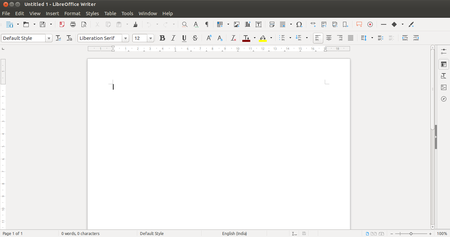
|
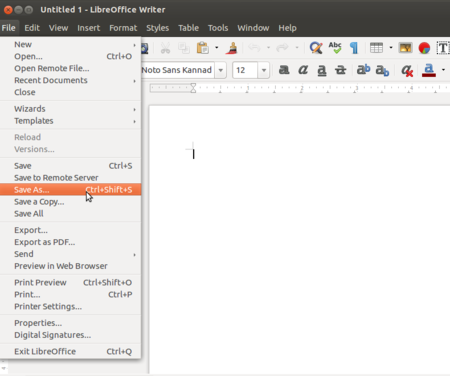
|
| Step 1- When you click on Application - Office - LibreOffice Writer, the main page will show like this. You can add text, image, table and graphs here. You can also type in multiple languages in same page. To change the language click on "EN" button in top panel. | Step 2- When you start entering text into the document, save your document by using SVAE option. Documnets can be saved using the FILE – SAVE option or by using short-cut key CTRL+S. Always give a meaningful file name for your documents. |
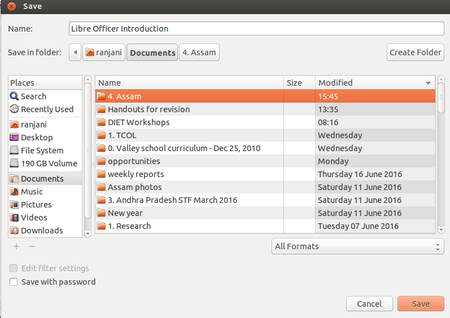
|

|
| Step 3- As like above image, after selecting file name and folder click on "SAVE".
File will be saved in.odt format, ODT is the short form of Open Document Text. ODT conforms to Open Document Format (ODF) which is recommended by the Government of India through its Policy on open standards”. |
Step 4- The Menu Bar has the following options:
1. File menu has options for File Save, Close, Print |
| 450px | 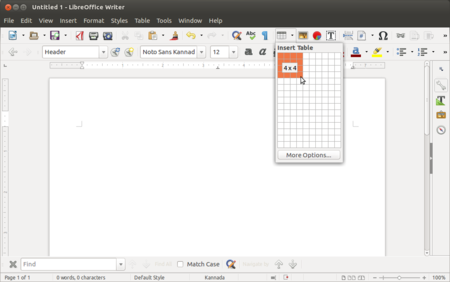
|
| Step 5- Insert menu option is for inserting Images, Hyperlinks, charts, page numbers, page breaks, formulas. | Step 6- Format option is for changing the format of the text, changing the text font, text size, page format and text wraping options. many of these option we can use shortcut icons from formatting text tool bar, the letter “B” and “I” can be used to make the text bold and italics. |
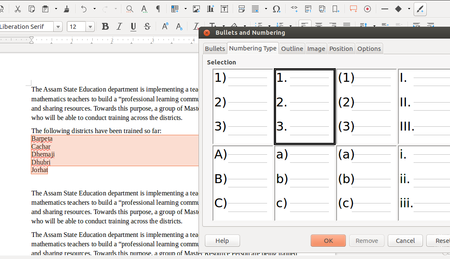
|
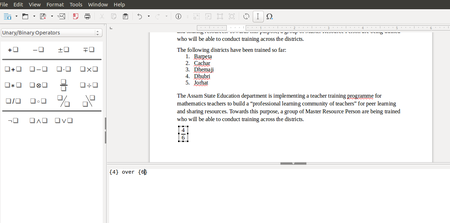
|
| Steps 7- You can also create numbered lists in a Writer document.
For this select the text input that has been entered, go to Format, select Bullets and Numbering and choose the numbering type that is needed. |
Steps 8- To insert a formula, go to Insert → Object → Formula.
It will open a window as shown – a left panel which has various options for formulas and a bottom panel in which the formula is to be constructed. |
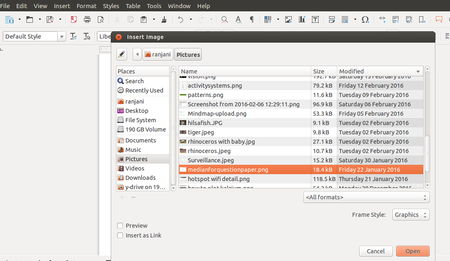
|
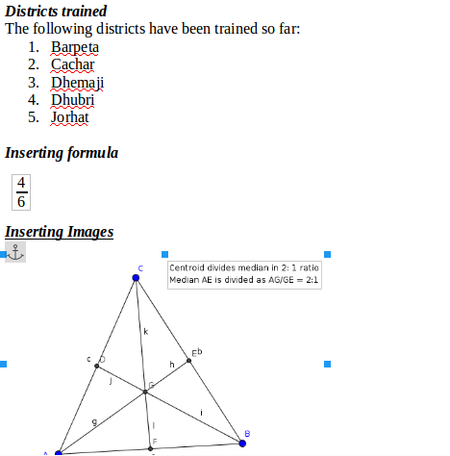
|
| Steps 9- Go to Insert → Image → This will open a folder from which images are to be inserted. | Steps 10- The image inserted above looks like this. |
| 450px | 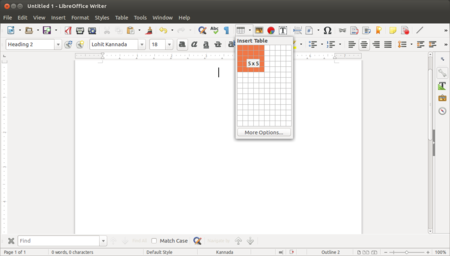
|
| Steps 11- To insert Table, go to Table from Menu bar and select "Insert Table", in given window choose required number of rows and columns.
You may have already entered data in a spreadsheet. You can simply copy that data (in rows and columns) from the spreadsheet and paste into the document, it will create a copy of the spreadsheet in your document. If you do not want it as a spreadsheet, but only as a table, you need to select 'Paste Special -> Formatted text (RTF)' option |
Steps 12-Alternatively you can also insert table from toolbar, Click on table grid from toolbar and move the cursor over the grid until you highlight the number of columns and rows you want. Click and the table appears in the document.
You can format your table by selecting the options in 'Table'. Move your cursor inside the table and 'Select -> Table'. You can then adjust the row and column widths (Table -> Size), add or remove borders (Table -> Properties -> Borders), split or merge cells (Table -> Merge Cells, Table -> Split Cells) etc. |
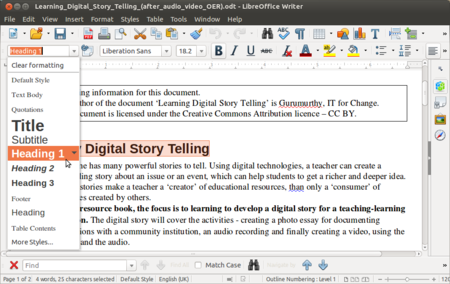
|
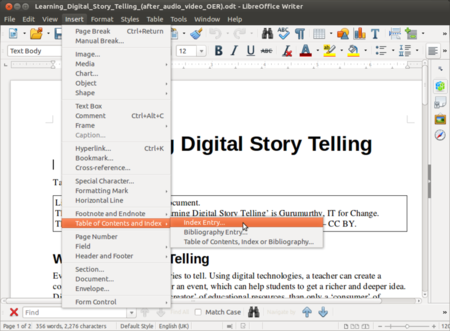
|
| STEP 13 - To insert table of content or table of index in your document, before that need to apply predefined headings style such as “heading 1” to the paragraph from the text formatting tool bar which you need to inculde it in your table of content. Select the text, click on the paragraph style option and select the heading type. |
STEP 14 - Click in your document where you want to create the table of contents. Choose Insert - Table of Contents and Index – Index Entry, just click on “OK”.
For updating table of content, just right click on the Table of content and Update Index or Table of Contents. |
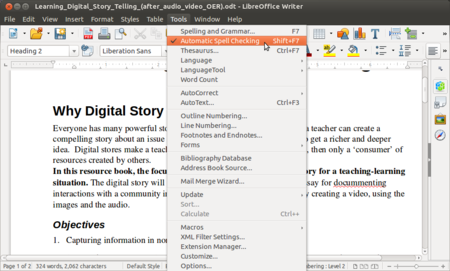
|
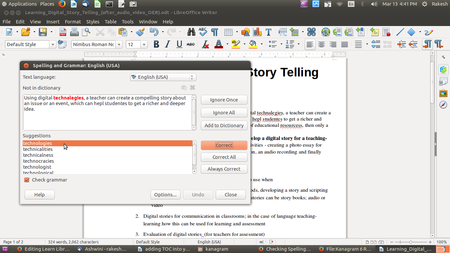
|
| Step 14- by enabling Automatic spell checking under tools, it will start checking spelling within your document and it will show red underline in wrong word. To check the spelling and the grammar of a text, the appropriate dictionaries must be installed.For each language dictionary will covers one language only. |
STEP 15- Also, can use manual spelling and grammar checking. Select the text and click on spelling and grammar under tools option. it will start looking spelling and grammar for the sentence. |
File formats for creation
Saving the file
Like in most applications, a file can be saved using the FILE – SAVE command, or by the shortcut key CTRL+S. Always give a meaningful file name, reading which you should get an idea of the file contents. Often adding the month-year information when the file was created can be useful later File will save in .odt format, ODT is the short form of Open Document Text. ODT conforms to Open Document Format (ODF) which is recommended by the Government of India through its Policy on open standards”.
Export and publishing files
Like in most applications, a file can be exported to a PDF format. This is useful when you only need to print the file and do not want any changes to it.

Advanced features
- Text alignment
- Inserting Drawings
- Flexible Application Interface
- Help Functions
Installation
| Method of installation | Steps |
|---|---|
| From Ubuntu software Centre | Search LibreOffice writer |
| From Terminal | sudo apt-get install libreOffice-writer |
| From the web | Go to libreOffice.org and download files to install |
| Web based registration | Not Applicable |
The application on mobiles and tablets
We can open/read these .ODF format files in the Android phones or tablets by installing "OpenDocumentReader" App and WPS Office App.
Ideas for resource creation
You can use this application to create and edit text resources. You can insert images, web links, hyper links in the document and connect the text to other resource formats. You can insert and edit tables, create sections (with section headings) and format it in many ways to create a text document.
